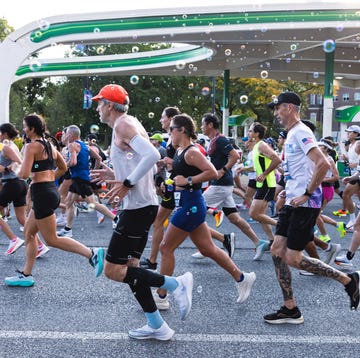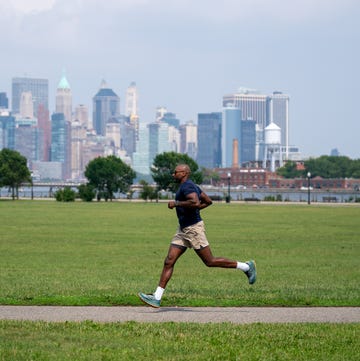Earlier this year, I interviewed Chari Hawkins about training for her first marathon. She initially set a goal to run a sub-5:30 marathon, then decided she would shoot to break four. “All it takes is a goal and a step. If you make a goal and you’re clear and then you take a step toward the goal, it is pretty wild what we can accomplish,” Hawkins told me at the time.
Hawkins finished the London Marathon in under 4:15—way faster than her original goal.
I’m running my first marathon this fall, and inspired by Hawkins’s grit, I took a good look at my half marathon PR (1:43), consulted a pace calculator, and decided to aim high for my own goal time.
While I know I can shoot to simply finish the race and that would be an accomplishment on its own, I thought about how much I enjoyed the Runner’s World break 1:45 half marathon training plan and wanted to follow a plan that was equally, if not more, challenging. Considering I had already run two half marathons and felt strong after the 1:43 finish, I did the math: I could maybe, just maybe, break 3:30.
To find out if I’m daring or delusional, I spoke with Danny Mackey, head coach of Brooks Beasts Track Club, about the benefits of setting a time goal for the marathon that feels just out of reach, and how to train for that goal, without overdoing it.
The Benefits of Chasing a Faster Time Goal
It turns out I’m not alone in setting lofty goals. “My first marathon experience was somewhat similar,” says Mackey. “I actually set a PR in the half marathon, during my second half of the marathon. So I can appreciate and relate to being a little bit unrealistic, but also having it work out.”
While there’s no telling what I’ll run until race day, here are all the reasons aiming high is helping me train better.
1. Addressing Weaknesses
Mackey points out that training for a higher-reach goal can expose weaknesses in my training that I might not have experienced if I chose an easier goal. This is helpful, he says, because I can then tackle limitations early on in my training and avoid dealing with injury or burnout closer to the race.
For example, I’ve picked up on a potential weakness in my left glute and/or hamstring; pain typically flares up when I don’t keep up with my strength and mobility work. Now I know if a hamstring cramp starts to pop up during or after my runs, I need to address it with more glute-focused strength work.
2. Becoming More Dedicated
Setting a fast goal also gives me an added layer of intention, because I have to make the most of the limited time I have to train. This is especially important for recreational athletes who tend to juggle training with work and social obligations, Mackey says. If you’re serious about your goal, then your whole day revolves around getting more out of yourself, he says, like prioritizing nutrition, staying hydrated, and getting enough sleep at night.
“If something is not easy, there’s a certain level of bracing that happens,” Mackey says, including psychological and physical elements that go into tackling something really difficult. For example, if Mackey told me to run a 5:30 mile, I’d probably stand up taller or warm up more thoroughly than if he told me to run a 9:30 mile.
3. Pushing Beyond Limits
Not all recreational runners push themselves like elites, but Mackey argues that we would benefit from doing so. “To a certain degree, humans thrive under pressure,” says Mackey. “People want to be challenged from a motivational standpoint. They want to be pushed. It’s a very good and healthy thing to do for yourself.”
While it’s enough to have a deep-seated belief that I can push myself to achieve my dream PR, it’s also important to look toward others as examples of achieving the impossible, Mackey says.
For example, I look at Cooper Lutkenhaus, the 16-year-old track and field phenom who crushed the men’s 800-meter at the USATF Outdoor Championships in Eugene, Oregon, placing second. I’m in awe of how fast he can run at such a young age. He finished 0.11 seconds behind Donovan Brazier, another model for inspiration. Brazier only returned to training six months ago after a three-year hiatus, yet ran his personal best. His ability to return to the sport he loves with full force after time away motivates me to do the same.
Plus, the world just watched Faith Kipyegon attempt to break four minutes in the mile despite a seven-second gap standing in the way. Even though she didn’t reach her goal then, she broke her own 1500-meter record just nine days later. Just as Kipyegon “dared to try,” as she often says, I want to see where my attempt will get me.
Mackey also uses one of his own athletes as an example: Josh Kerr, Olympic middle-distance runner who holds the world best time in the short track 2-mile. “When Josh won a world title, he had never won one before. He’d never been the best in the world. We had to do something that he had never done,” he says.
There are plenty of professional runners that prove I don’t have to limit myself to goals that I’d typically expect to meet, because I just might surpass what I thought was possible.
How I’m Training for a Faster Time Goal Without Risking Injury or Burnout
Setting a faster goal time is one step... actually training for it is another. I know I have to train hard and recover harder. To draw the line between ambition and overtraining, Mackey offers some mental and physical tips.
1. I’m Paying More Attention to Effort
While I may be setting a big goal, I don’t want to feel like I’m overdoing it in training just to keep pushing. So far, I built two full rest days a week and supplemental strength training into my plan so I can fully recover between workouts and avoid injury.
Mackey suggests watching out for some key signs of overtraining, like sleep disruptions, loss of motivation, frequent illness, or weight fluctuations. If any of these signs show up for more than three days in a row, it’s time for another rest day or even reevaluating the training plan.
2. I’ll Change My Approach First, Before Adjusting My Goal
If I run into bumps in my training plan, then I don’t have to throw out the whole goal entirely. Instead, I can tweak my plan. This might include moving a rest day around, adding an extra easy day, slowing down my recovery pace, or getting more sleep. If I find a pattern that lasts for more than two weeks where I’m struggling with training or not hitting workout splits—especially in the second half of my plan—then it’s time to adjust my goal.
A change to my goal doesn’t have to be drastic, though, Mackey says. While I’m fully prepared to jump to a more easily attainable time goal, like breaking four hours (or simply finishing in one piece), Mackey recommends making small adjustments that can still satisfy my inner fire while being a bit more attainable. This could look like dropping my goal time by two to three percent at a time, like moving from breaking 3:30 to breaking 3:35.
“That’s the cool thing about pushing yourself really hard,” says Mackey. “A couple percent adjustment on your overall time could be all the difference.” He explains that making this small adjustment would hopefully lead to feeling fresher in workouts, and that I just might wind up running faster than I expect anyway.
3. I’m Challenging My Fears and Doubts
Even though I’m excited to push myself, I’m still dealing with feelings of self-doubt and fear. “That’s a very human, normal response to achieving something that has some stress involved with it,” Mackey says. “It would be weird if you didn’t once think that it could go bad or doubt that you’d be able to execute it.”
While that doubt creeps in from time to time, I don’t want to give it all my power. To avoid that, Mackey recommends first listening to that voice and addressing it with compassion. “As soon as you respect that little part of your voice, it kind of calms down a little bit,” he says.
After that, challenge the doubtful voice by asking, “why wouldn’t I be able to reach my goals?”
Mackey explains that reviewing my training progress can help to silence the doubt, and tap into a more objective “inner coach” voice. For example, I’m hitting a majority of my splits so far in workouts, so technically, I’m on track to meet my goal. The only logical reason I might not break 3:30 is that this is my first marathon. “But that’s it,” he says.
If I keep focusing on what is working—rather than what might not—I’ll keep believing in myself all the way through the finish line.
Even though I won’t run the full 26.2 miles until race day, I’ll have at least a few long runs and workouts that simulate the race day effort, which allows me to put myself in the race, Mackey says. Lucky for me, I do most of my runs on the same trail where I’ll be racing my marathon, so during each long run, I closely visualize what I’ll face on race day. With that in mind—and a mostly flat course—there’s nothing stopping me from vying for that fast time.

Kristine Kearns, a writer and avid runner, joined Runner’s World and Bicycling in July 2024. She previously coached high school girls cross country and currently competes in seasonal races, with more than six years of distance training and an affinity for weightlifting. You can find her wearing purple, baking cupcakes, and visiting her local farmers market.













